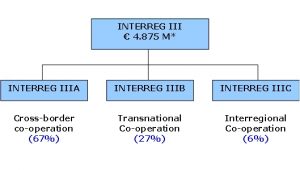INTERREG III is one of the four Community Initiatives . It was launched on 28th April 2000 following the positive experiences of its predecessors INTERREG I, INTERREG II and REGEN. It aims to stimulate transeuropean cooperation between years 2000 and 2006. The current phase of the INTERREG initiative is designed to strengthen economic and social cohesion throughout the EU, by fostering the balanced development of the continent through cross-border, transnational and interregional cooperation. It is therefore divided into three strands (A, B and C).
The INTERREG III Community Initiative receives funding from the EU and the Member States. EU financing comes from the European Regional Development Fund (ERDF), in the form of non-reimbursable grants. In total, INTERREG III has an ERDF budget of €4,875 million at 1999 prices. This funding was allocated to the three strands – A 67%, B 27% and C 6%.
Under the Strand B the EU territory (including the neighbouring regions) was divided into 13 different strategic areas (macro regions) (see the picture below). Each of the areas forms an independent programme with a separate budget, management, specific thematic focus, specific implementation procedures, etc.
The Commission delegated the responsibility for the implementation of the INTERREG III B programmes to the countries that are covered by particular programme. All INTERREG III B programmes foster transnational cooperation between national, regional and local authorities “to promote a higher degree of territorial integration across large groupings of European.
regions, with a view to achieving sustainable, harmonious and balanced development in the EU and better territorial integration with candidate and other neighbouring countries”. A special focus of this transnational cooperation is put on spatial planning and regional development.
One of the INTERREG III B programmes is the Baltic Sea Region Neighbourhood Programme. It is seeking to strengthen economic, social and spatial cohesion by focusing on disparities between different territories in order to reach an increased level of BSR integration and to form a sustainable part of Europe. It is a continuation of the INTERREG IIC BSR Programme, which was also designed to provide co-financing to transnational projects on spatial planning and regional development in the BSR.
The BSR INTERREG III B Neighbourhood programme is implemented in line with the Northern Dimension Action Plan, the VASAB 2010 strategies, and with the programmes of the Council of the Baltic Sea States (CBSS), HELCOM and Baltic 21.
